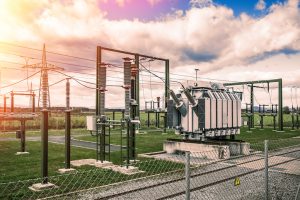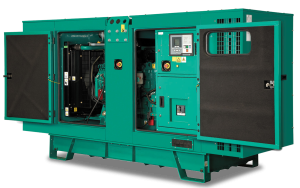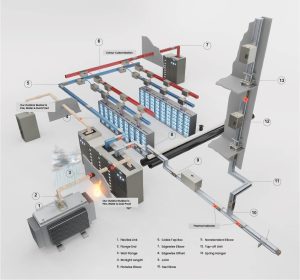 An electrical substation, commonly referred to as a “substation” is a specialized facility within the electrical power system that performs the essential functions of voltage transformation, distribution, protection, and control. It serves as an intermediary point between the high-voltage transmission lines that carry electricity over long distances and the lower-voltage distribution lines that supply power to homes, businesses, and industries. Electrical substations play a critical role in ensuring the efficient and reliable delivery of electricity to end-users.
An electrical substation, commonly referred to as a “substation” is a specialized facility within the electrical power system that performs the essential functions of voltage transformation, distribution, protection, and control. It serves as an intermediary point between the high-voltage transmission lines that carry electricity over long distances and the lower-voltage distribution lines that supply power to homes, businesses, and industries. Electrical substations play a critical role in ensuring the efficient and reliable delivery of electricity to end-users.
Key features and components of an electrical substation include:
In summary, electrical substations are vital components of the electrical power infrastructure, facilitating the efficient transmission and distribution of electricity while ensuring the safety of equipment, personnel, and the environment. Their strategic location and well designed systems contribute to the reliable and uninterrupted supply of electricity to meet the needs of society.
 A generator is a device that converts mechanical energy into electrical energy. It plays a crucial role in various applications, ranging from powering homes during blackouts to providing electricity in remote areas, as well as serving as a backup power source for critical infrastructure and industrial processes. Generators are essential for ensuring a stable and reliable supply of electricity in various situations.
A generator is a device that converts mechanical energy into electrical energy. It plays a crucial role in various applications, ranging from powering homes during blackouts to providing electricity in remote areas, as well as serving as a backup power source for critical infrastructure and industrial processes. Generators are essential for ensuring a stable and reliable supply of electricity in various situations.
Key components and concepts related to generators include:
Principle of Operation: Generators operate on the principle of electromagnetic induction, discovered by Michael Faraday in the early 19th century. When a conductor (such as a coil of wire) moves within a magnetic field or experiences a change in magnetic flux, an electromotive force (EMF) is induced in the conductor, leading to the generation of an electric current.
Types of Generators:
Prime Mover: The mechanical energy required to turn the generator’s rotor and generate electricity is provided by a prime mover. Prime movers can be internal combustion engines (such as diesel or natural gas engines), steam turbines, water turbines, wind turbines, or other sources of mechanical power.
Rotor and Stator: The generator consists of a rotor (the rotating part) and a stator (the stationary part). The rotor typically contains coils of wire that rotate within a magnetic field, while the stator contains stationary coils that interact with the rotor to induce the flow of electric current.
Output Voltage and Frequency: The output voltage and frequency of a generator depend on factors such as the speed of rotation, the number of poles, and the design of the generator. These parameters are crucial for ensuring compatibility with the electrical system it is connected to.
Synchronous and Asynchronous Generators:
Generator Control and Protection: Generators are equipped with control systems that regulate their output voltage, frequency, and other parameters. Protection systems are also essential to monitor conditions such as overloads, short circuits, and voltage fluctuations to prevent damage to the generator and ensure safe operation.
Standby and Backup Power: Generators are frequently used as backup power sources during power outages. They provide essential electricity to critical facilities like hospitals, data centers, and emergency services, ensuring continuity of operations.
Efficiency and Fuel Source: The efficiency of a generator refers to the ratio of electrical output power to the mechanical input power. Different types of generators and prime movers have varying levels of efficiency. Generators can be powered by a range of fuels, including diesel, natural gas, gasoline, coal, and renewable sources like wind, solar, and hydroelectricity.
Generators play a vital role in maintaining electricity supply and supporting various sectors of society, from residential to industrial and commercial. Their versatility and adaptability make them indispensable components of modern infrastructure.
 A busbar trucking system, also known as a bus duct system or busway system, is an electrical distribution system used to efficiently and safely transfer electrical power from one point to another within a facility or building. It provides a flexible and compact alternative to traditional cable and conduit systems for distributing power to various loads, such as motors, machinery, lighting, and other electrical equipment.
A busbar trucking system, also known as a bus duct system or busway system, is an electrical distribution system used to efficiently and safely transfer electrical power from one point to another within a facility or building. It provides a flexible and compact alternative to traditional cable and conduit systems for distributing power to various loads, such as motors, machinery, lighting, and other electrical equipment.
Key features and components of a busbar trucking system include:
Busbar Assembly: The busbar assembly consists of conductive metal bars (busbars) that carry electrical current. Busbars are typically made of aluminum or copper and are designed to handle high current loads. They are arranged in an enclosed housing or enclosure.
Enclosure: The busbars are housed within a protective enclosure, which can be made of materials such as sheet metal or composite materials. The enclosure provides mechanical protection, electrical insulation, and a controlled environment for the busbars.
Busbar Configuration: Busbars can be arranged in different configurations, such as straight runs, elbows, T-junctions, and intersections, to accommodate the layout of the facility and the specific power distribution needs.
Insulation: Busbar trucking systems incorporate insulating materials to prevent contact between the live busbars and external objects or personnel. Insulation ensures electrical safety and reduces the risk of electrical faults.
Jointing and Connection: Busbars are connected using jointing techniques that maintain electrical continuity and ensure a reliable connection. Proper jointing is essential for maintaining low electrical resistance and minimizing losses.
Supports and Suspension: The busbar system is supported by hangers, brackets, and other support structures. These elements help secure the busbars in place and ensure proper alignment.
Rating and Current Capacity: Busbar trucking systems come in various current ratings, voltage classes, and configurations to meet the specific power requirements of the facility. The current capacity of the system is determined by factors such as conductor size, insulation, and cooling.
Tap-offs and Outlets: Tap-offs or outlet boxes are used to distribute power from the main busbars to individual loads. These outlets can be easily added or relocated, allowing for flexibility in modifying the power distribution layout.
Cooling and Ventilation: Busbars can generate heat due to the flow of electrical current. Some busbar systems incorporate cooling techniques such as air circulation, natural convection, or forced cooling to maintain safe operating temperatures.
Advantages: Busbar trucking systems offer advantages such as reduced installation time, lower maintenance requirements, improved power distribution efficiency, and the ability to accommodate future expansions or modifications with ease.
Applications: Busbar trucking systems are used in a wide range of applications, including industrial facilities, commercial buildings, data centers, substations, and power distribution centers.
Overall, a busbar trucking system provides a reliable and efficient solution for distributing electrical power within a facility, contributing to safe and effective power distribution while minimizing installation and maintenance efforts.
Internal Electrification System: Internal electrification refers to the electrical infrastructure and components installed within a building or structure to provide power for lighting, appliances, equipment, and other electrical loads used by occupants. It encompasses the wiring, distribution panels, switches, outlets, lighting fixtures, and other electrical components needed to ensure a safe and functional electrical supply within the building’s interior spaces.
Key components of an internal electrification system include:
Wiring: Electrical wiring runs through walls, ceilings, and floors to connect electrical outlets, switches, and fixtures to the main distribution panel. Proper wiring ensures safe and efficient electricity distribution.
Distribution Panels: Distribution panels or electrical panels house circuit breakers or fuses that protect electrical circuits by interrupting the flow of electricity in case of overloads or faults.
Switches and Outlets: Light switches and electrical outlets are strategically placed throughout the building to provide convenient access to power for various devices and appliances.
Lighting Fixtures: Lighting fixtures include ceiling lights, wall sconces, pendant lights, and other fixtures that provide illumination to interior spaces.
Appliance Connections: Outlets are installed to connect appliances such as refrigerators, ovens, computers, and entertainment systems to the electrical supply.
Safety Measures: Internal electrification systems incorporate safety features such as grounding, circuit protection, and insulation to prevent electrical hazards.
External Electrification System: External electrification refers to the electrical infrastructure installed outside a building or structure to provide power for outdoor lighting, security systems, outdoor equipment, and other purposes. It involves setting up the necessary electrical components to deliver electricity to outdoor spaces, pathways, driveways, and landscape features.
Key components of an external electrification system include:
Outdoor Lighting: External electrification includes lighting solutions such as streetlights, pathway lights, floodlights, and decorative lighting fixtures that illuminate outdoor areas.
Security Systems: Surveillance cameras, motion sensors, and other security devices are powered by the external electrification system to enhance safety and security around the building.
Power Outlets: Outdoor power outlets are strategically placed to provide access to electricity for tools, equipment, and appliances used in outdoor activities or maintenance.
Cable Management: Underground conduits or overhead cable management systems are used to route electrical cables safely from the main power source to outdoor fixtures and equipment.
Safety and Weatherproofing: Components of the external electrification system are designed to be weatherproof and resistant to environmental conditions to ensure reliable operation and longevity.
Landscaping and Aesthetics: External electrification may also involve integrating electrical components seamlessly into the landscape design for aesthetic purposes.
Both internal and external electrification systems are essential for providing a complete and functional electrical infrastructure to meet the diverse needs of a building and its surroundings. These systems contribute to convenience, safety, and the overall functionality of residential, commercial, and industrial spaces.
Please feel free to contact us. We will get back to you with 1-2 business days. Or just call us now
WhatsApp us
